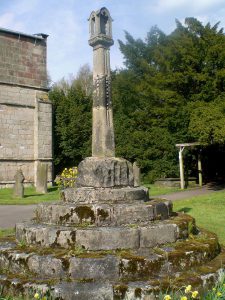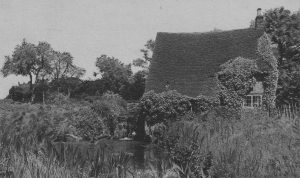History pages
- History map and tour
- Lower Street Farm
- Methodist Chapel
- Reading Room
- The Church
- The Gables
- The Hall
- The Water Mill
- The Well
- The Yew Tree
- Village School
Quicklinks
A short tour of Doveridge history
Join us, if you will, as we tour the village. Along the way we will stop while you look at what we have to offer.
NOTE: You can click on the markers to reveal more information, drag the map with your mouse, zoom in and out with the controls in the top left corner or select alternative views with the buttons at top right.
The journey will not be too taxing: we promise not to inundate you with facts and figures but, for those of you who wish to know more, we will provide details of publications. The numbers in the text 99 correspond to the markers on the map.
Where do we begin? Well, we could try to impress by telling you about Neolithic artefacts found in the fields to the north of the village. The problem is, you may ask us who made the stone hand axe or the adze and Palstave. We would be a bit embarrassed then because even our oldest Parish Councillors can’t remember 5000 years back. In fact they can’t even recall if we were visited by the Romans from nearby Rocester, and that’s only 2000 years ago.
Far better if we begin with the Saxons and then move on. to the Domesday survey. We are sure you will recall the date of the Domesday Book which was completed in 1086. The entry for Doveridge bears the initials ‘TRE’ which means that the survey took into account details of the village pertaining to the time of ‘The Reign of Edward’. So, as Edward the Confessor died a few years before the arrival of William the Conqueror in 1066, we can safely assume that Doveridge was a Saxon village. We had a priest, a church, a mill and a population of about 180 people who, in the main, earned a living from agriculture.
Unfortunately, the WATER DRIVEN CORN MILL 12 was demolished in the mid 20th century. Today we would fight for a grant and restore it. As it was, we lost over 1000 years of history with little more than the stroke of a pen. We do have a rather nice picture of the mill to remind us of our loss and if you walk down the hill with the church on your right and follow the path towards the suspension bridge, you will cross the remains of the mill race. We now, also, have the Doveridge Preservation Society to prevent such things happening again.
THE CHURCH 1, dedicated to St. Cuthbert, is extant as you would expect. We are a bit biased but, to be honest, we think we have a lovely church. Most of the architecture is 13th century but, if you look a little closer will find a rather nice Norman arch over the north door.
The church guide is inexpensive and gives you details of prominent individuals who supported the village and the church. Hatchments and marble effigies rest in peace amidst the choir stalls, pews, reredos and pulpit. On a sunny day the sunlight, shining through the stained glass windows, creates an ambience to be envied.
Our priests have cared for our church and, in return, we have cared for them. In fact, we have been keeping tabs on them since the 14th century when William de Longsdon and Richard de Ossyngton were our parish priests and the monks of Tutbury Priory were patrons.
Our village was just one of many villages and estates handed to the priory by Berta, the wife of Henry Ferrers, when the priory was formed about 1087. Doveridge must have been the prize possession because, along with its appurtenance of West Broughton, it provided the priory with 34% of its total income which included the payment of tolls by traffic passing over the Dove bridge. It is only in relatively recent times that we have referred to the village as Doveridge. It was previously Dovebridge.
Before you leave the church why not take a look at one of the oldest YEW trees in the county. Legend has it that the tree was familiar to Robin Hood and our vicars have been asked on more than one occasion if Robin and Marion’s name is in the parish register. We should be so lucky but, we do try not to smile.

Nearby is an ancient STONE CROSS which originally stood in the centre of the village. It has had several homes within the village but is now well established as the WAR MEMORIAL and fits well in the sanctity of the graveyard. We have no definitive history of the cross although it may well have graced the market place in 1215 or even been of significance to our Saxon forefathers who carved the patterns on part of the column and cut the steps on which goods for sale could be placed. We leave the conclusions to your imaginations.
DOVERIDGE HALL 2, of which we can only show you a picture, stood to the north of the church and was built for Henry Cavendish around 1771. The Cavendish family, better known as BARON WATERPARK were ‘Lords of the Manor’ for almost 400 years and only left Doveridge in the 20th century when the male line failed and the title passed to a cousin who was well established elsewhere. The chairman of the Preservation Society, TIM DEVILLE, has a detailed history of Cavendish of Doveridge which is far too long for your brief, but welcome, visit.
Before 1771 the Cavendish family would have lived in some style but in nothing like the manner of Henry Cavendish 1st Baronet, who had the hall built. We have two contenders for the family residence and both were on LOWER STREET. Lower Street is the oldest part of the village and forms part of the medieval route which ran between Tutbury and Uttoxeter. The Tudor house, now called LOWER STREET FARM 4 and its neighbour, OLD HALL FARM both have a pedigree worthy of consideration but research suggests that the Tudor building, which has been dated as mid 1500s is the more likely.
Whilst on Lower Street take a few minutes to look at the other farms, the cottages on the corner of PICKLEY’S LANE, THE GABLES [17th century] 5 and SLADE HOUSE [18th century].

Continue your journey by walking up Pickley’s Lane to where it passes the 19th century Manor House7, once the home of the Hammersley family who had links with the potteries and the QUAKERS. Just a few yards away stands the METHODIST CHAPEL 6, built in 1805 with the encouragement of JOSEPH SADDLER and still going strong.
Opposite you will find the PRIMARY SCHOOL with its light airy class rooms complete with computers and the more traditional books and blackboard.
The original schools still stand as a testament to village education. On the comer of the HIGH STREET and PUMP LANE you will see the red brick home of the late Frank Beckett. Frank’s house was once the village school 8 and dates from around 1787. It has since been used as a BAKE HOUSE and a POST OFFICE and the workshop for Frank’s carpentry. When the Becketts gave up the post office in the 1960s a new POST OFFICE and VILLAGE STORE was established on the other side of Pump Lane where the old WHEEL-WRIGHT and WOOD-YARD once stood.
A little farther along the High Street stands the second village school [1841] Distinguished by its architecture and the attached SCHOOL HOUSE 9 this is the school which still remains in the memory of our older residents who recall with affection the efforts of headmaster SIDNEY TWIGG, who devoted his life to the children of Doveridge. Mr.Twigg started at the school in 1910 and retired in 1951. We think we can chalk that into the record book.
Finally, if you stand with your back to the old school and look towards the end of the row of terraced cottages, you will see a stone set in the gable bearing the legend `READING ROOM‘ 10. It became a reading room in 1900 just before education became compulsory for both boys and girls. Before that it was the home of the PRIMITIVE METHODISTS who were established there by at least 1841.

As you will appreciate, the village has a lot more to offer, so why not leave the computer screen and pay us a visit. There is a convenient cafe attached to the post office and within walking distance you will find the WORKING MEN’S CLUB and the CAVENDISH ARMS 11, formerly The Anchor. All three would make you welcome.
There is much to see in the village: far more than we can portray on a web page, but it would take time.
There are books in Uttoxeter library, including the millennium book which the members of Doveridge Preservation Society initiated. The popular History of Doveridge is now out of print but, we are reliably informed that research is well in hand for a bigger and more detailed edition by Alan Gibson.
Glimpses from 1857
(Images and notes supplied by Tony Lyon)




I was recently given a copy of Francis White and Co’s Directory and Gazetteer of Derbyshire, published in 1857. It’s rather dilapidated, but complete. It contains a lot of information about Doveridge. I offered the book to the Derbyshire Record Office, and they came and collected it next day!
They have sent me images of the pages I wanted, which I think will be of interest to others in the village. They include a list of the parishes in Appletree Hundred, giving populations from 10 yearly census returns 1801-1851, and several pages about Doveridge.
Seventy years ago
(Images supplied by Judith Doyle)
These postcard images have been supplied by Judith from scans of postcards purchased by her grandfather on a visit to Doveridge in 1946. Click on any of the images to see an enlarged version.



More to tell?
If you have an interesting piece of our history that you would like to add to this page, please send it to
our web editor.